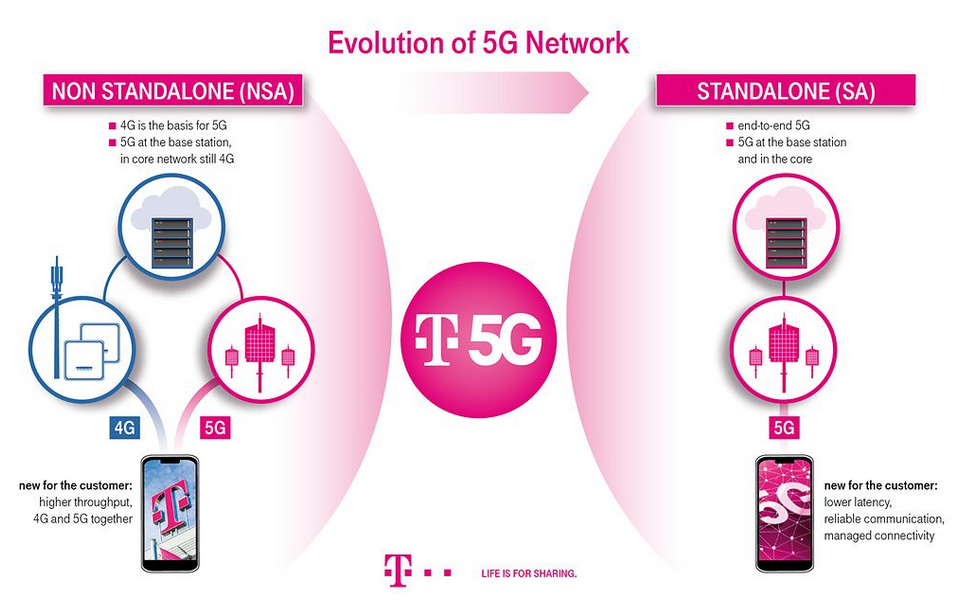Verizon trails T-Mobile and AT&T over use of the superior 5G standalone network

When the major U.S. carriers first started offering 5G, they simply used networks with 4G cores to save time and money. There was extremely fierce competition among wireless providers to offer faster data speeds to as many subscribers as possible. But now that some time has gone by, a standalone 5G network (SA) is used by T-Mobile and AT&T has started moving its customers to its standalone 5G network.
Verizon is three years behind its original plan to launch its 5G standalone network in 2020
A 5G standalone network is built specifically for 5G use. It combines a 5G radio access network (RAN) with a 5G core. Improvements include faster speeds and larger coverage compared to non-standalone 5G. It also brings support for higher-density deployments of devices, and support for low-latency and real-time usage. It also supports 5G slicing which uses software to divide single network connections into multiple connections that can deliver different resources to different types of network traffic. And 5G SA offers better security than 5G NSA (non-standalone).

5G standalone networks deliver the superior wireless experience to subscribers
Per LightReading, Verizon originally said that it would launch 5G SA in 2020. Two years later, a report citing an unnamed Verizon rep said that Verizon was migrating "commercial traffic onto SA 5G core." This past September, Mike Haberman, Verizon's SVP of strategy and transformation, said during a webinar for analysts, "If you guys have read the stuff we've said publicly, certainly we serve some customers on portions of our 5G core And then we have some internal stuff going on with other functionality on the core. We're in the process of rolling out in a very smart fashion."
But now it appears that Verizon doesn't have 5G SA available for its customers. Joe Russo, Verizon's chief networking executive, said in a podcast last month, "We have it in trials only at this point. We don't have it commercially available for our customers. So more to come in the next several months as Verizon will be entering the standalone core game." Russo's comment was clarified by Verizon spokesperson Kevin King who said, "We have commercial traffic running on our 5G non standalone core. That is what we announced earlier in the year. Joe was referring to our 5G standalone core which is in testing now."
Verizon executive says that 5G standalone needs a little more time
Yet, Verizon last April published a story on its website about 5G standalone and the benefits of 5G (SA). While the story said that 5G (SA) is "what sets Verizon apart," the article didn't say that Verizon had launched its 5G (SA) network.
Verizon's Russo has stated that 5G (SA) needs a little more time although Verizon is already three years behind its original plan. Russo also said, "We're doing significant developing and testing to make sure that both the data session and the voice sessions in a standalone world are as good or better than what you would expect in our 4G network today. So we see that in the next several months we're going to get there, but it was not my goal to be first in deploying standalone. It's my goal to be best in deploying standalone."
T-Mobile launched its 5G standalone network in 2021 to improve the coverage of its low-band 600MHz network. It also is helping T-Mobile open more business accounts. AT&T is starting to move its customers to its 5G (SA) network. AT&T's chief networking executive, Chris Sambar, recently said, "Many of the newest mobile devices are ready for 5G standalone, and we continue to move thousands of customers every day. We also recently launched AT&T Internet Air home fixed wireless service, and from the start, this product rides on standalone 5G."
With all of the confusion and the delays, it isn't clear yet when Verizon plans on moving its wireless subscribers to its 5G (SA) network.
Follow us on Google News










![A new Android bug is making it impossible to install new apps. Are you affected? [UPDATE]](https://m-cdn.phonearena.com/images/article/176703-wide-two_350/A-new-Android-bug-is-making-it-impossible-to-install-new-apps.-Are-you-affected-UPDATE.webp)


Things that are NOT allowed:
To help keep our community safe and free from spam, we apply temporary limits to newly created accounts: